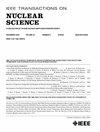p-GaN栅极高电子迁移率晶体管中栅极偏置相关单事件漏电流的研究
IF 1.9
3区 工程技术
Q3 ENGINEERING, ELECTRICAL & ELECTRONIC
引用次数: 0
摘要
本文研究了在重离子辐照下,不同栅极偏置对p型氮化镓高电子迁移率晶体管(HEMTs)漏电流的影响。在0 ~ - 5 V的栅极偏置$V_{\ mathm {gs}}$范围内,利用Ta离子辐照研究了漏损降解。在大约$V_{\mathrm {gs}}=-3$ V时,电测量显示阈值电压正移20% ($V_{\mathrm {gs}}=-3$ V时),导通电阻增加两倍,Schottky势垒高度降低,重离子暴露后理想因子显著变化。计算机辅助设计(TCAD)技术模拟表明,负栅极偏置大小的增加增强了内部电场强度,而晶格温度呈下降趋势。分析表明,在重离子辐照下,不同栅偏置下的漏电流主要是由热激发和载流子隧穿形成的微烧通道引起的,其可能性受内部电场和晶格温度的影响。在中间栅极偏置条件下,器件内部的电场强度和晶格温度都较高,导致微烧通道较多,漏电率明显高于其他偏置条件。这些发现可以为p-GaN HEMT器件在辐射环境下潜在应用中的单事件泄漏降解特性提供重要的理论依据。本文章由计算机程序翻译,如有差异,请以英文原文为准。
Investigation of the Gate Bias Dependent Single Event Leakage Current in p-GaN Gate High Electron Mobility Transistors
This study investigates the effect of different gate biases on the leakage current of p-type GaN high electron mobility transistors (HEMTs) under heavy ion irradiation. Utilizing Ta ion irradiation, the leakage degradation at the gate bias $V_{\mathrm {gs}}$ range of 0 to −5 V was studied. The most severe degradation was observed at approximately $V_{\mathrm {gs}}=-3$ V. Electrical measurements revealed a 20% positive shift in threshold voltage (at $V_{\mathrm {gs}}=-3$ V), a two times increase in on-resistance, a reduction in Schottky barrier height, and a significant shift in the ideality factor after heavy ion exposure. Technology computer-aided design (TCAD) simulations indicated that increasing the magnitude of negative gate bias enhanced the internal electric field strength, while the lattice temperature exhibited a decreasing trend. The analysis suggests that under heavy ion irradiation, leakage current at different gate biases is primarily attributed to micro-burn channels formed via thermal excitation and carrier tunneling, with their likelihood governed by the internal electric field and lattice temperature. Under the intermediate gate bias, the electric field strength and lattice temperature inside the device were both higher, resulting in more micro-burned channels and a significantly higher leakage rate than other bias conditions. These findings can provide an important theoretical basis for the single event leakage degradation characteristics during the potential application of p-GaN HEMT devices in radiation environment.
求助全文
通过发布文献求助,成功后即可免费获取论文全文。
去求助
来源期刊

IEEE Transactions on Nuclear Science
工程技术-工程:电子与电气
CiteScore
3.70
自引率
27.80%
发文量
314
审稿时长
6.2 months
期刊介绍:
The IEEE Transactions on Nuclear Science is a publication of the IEEE Nuclear and Plasma Sciences Society. It is viewed as the primary source of technical information in many of the areas it covers. As judged by JCR impact factor, TNS consistently ranks in the top five journals in the category of Nuclear Science & Technology. It has one of the higher immediacy indices, indicating that the information it publishes is viewed as timely, and has a relatively long citation half-life, indicating that the published information also is viewed as valuable for a number of years.
The IEEE Transactions on Nuclear Science is published bimonthly. Its scope includes all aspects of the theory and application of nuclear science and engineering. It focuses on instrumentation for the detection and measurement of ionizing radiation; particle accelerators and their controls; nuclear medicine and its application; effects of radiation on materials, components, and systems; reactor instrumentation and controls; and measurement of radiation in space.
 求助内容:
求助内容: 应助结果提醒方式:
应助结果提醒方式:


